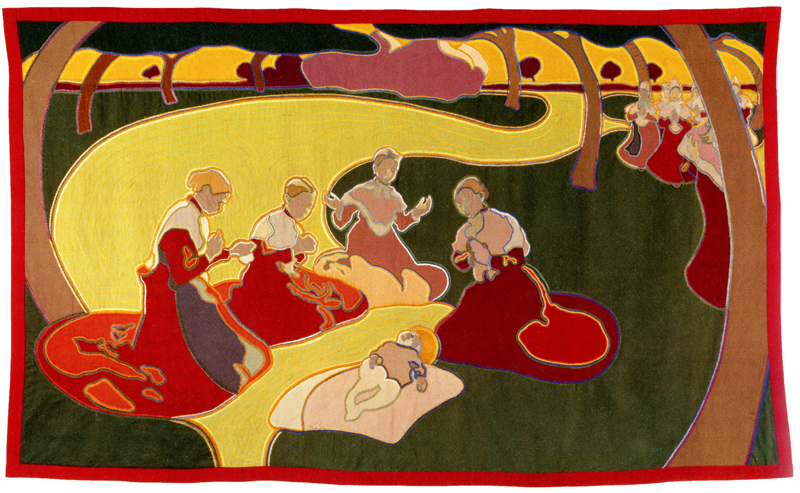
In celebration of Henry van de Velde‘s (1863-1957) 150th birthday, a catalogue of his works in 6 volumes, edited by Thomas Föhl and Antje Neumann, is currently being produced in German and English by the Klassik Stiftung Weimar. The first two volumes have been published, and the remaining ones on metalwork, ceramics & porcelain, furniture and interior art are under preparation. Numbering 460 pages, including ca. 60 pages of references, the volume on textiles contains numerous illustrations as well as 10 text contributions (ISBN 978-3-86502-230-1 ). A total of over 1,000 fabrics have been appraised.
Should all the books in the catalogue be similar to the textile volume in scope and treatment of their subject matter, this will be an exemplary publication dedicated to one of the most prolific European Art Nouveau designers. It deals with a period of incipient reforms in textile design which first came to the fore through William Morris in England, and later attracted attention on the European continent with the advent of attempts at a synthesis of the arts in Art Nouveau architecture, interior decoration and crafts. Jean Lurçat made his debut at Victor Prouvé‘s in Nancy during the same period.
‘Textiles’ opens with a review of van de Velde’s women’s and children’s clothing, which he and his wife Maria had begun designing in Belgium at the time. Shortly after the turn of the century, he was commissioned by the Saxon Grand Duke Wilhelm Ernst to attend to the country’s culture of craft and industry products. Between 1904 and 1911, van de Velde created the Art Nouveau building of the School of Arts and Crafts in Weimar where he held the position of Director until 1915. Together with Hermann Muthesius and politician Friedrich Naumann, Henry van de Velde co-founded the Deutsche Werkbund in 1907. During this period he designed his reform dresses which are described in detail in the book.
The ‘Interior Textiles’ chapter deals with wall hangings, decorative fabrics and functional textiles as well as carpets and floor coverings. As regards the wall hangings, a great deal of attention has been devoted to an embroidered piece entitled “The Angel’s Watch”, created in Belgium as early as 1892/93 and later to become a symbol of Art Nouveau. When creating the work, the architect-artist‘s intention was to emphasise its high standard of craftsmanship to imbue it with a greater physical presence, unlike the current understanding of art which emphasises the ‘spiritual’ presence of an image rather than its physical properties.
Van de Velde designed a variety of decorative fabrics for upholstery and wall coverings in a very restrained style, due to which he is considered the father of abstract surface design. On one occasion he commissioned the Scherrebek art weaving workshop in North Schleswig with creating covers for upholstered chairs.
Aside from discussions of doubtful attributions of textile objects to the total catalogue of works, the book includes an interesting contribution on Henry van de Velde‘s batiks by Dr Maria Wrońska Friend, a Polish-born cultural anthropologist now resident in Australia. The designer became acquainted with this Javanese textile technique while on honeymoon in Holland in 1894, began practising it in 1902 and continued to do so during his Weimar years. Japanese, Indonesian and other East Asian art techniques were highly popular at the time, and were frequently employed to decorate home interiors. The impetus mainly came from Dutch artists who had their batiks made by craftspeople. However, van de Velde was convinced that art, craft and industry should coexist on equal terms and had his batiks produced by textile manufactories in Holland, England or Switzerland. Unfortunately, his efforts to establish batik as a subject in his Weimar School of Arts and Crafts failed for organisational reasons, but his personal environment (studio and private rooms) always contained Javanese and European batiks.
Van de Velde´s Weimar period ended when his School of Arts and Crafts closed on account of the war. In 1919, van de Velde‘s School served as the spiritual basis for Bauhaus, founded in Weimar by the architect Gropius.
The ‘Interiors’ exhibition featuring works by Henry van de Velde is currently still on view (until 1st June 2014) at the Swiss Bellerive Museum.